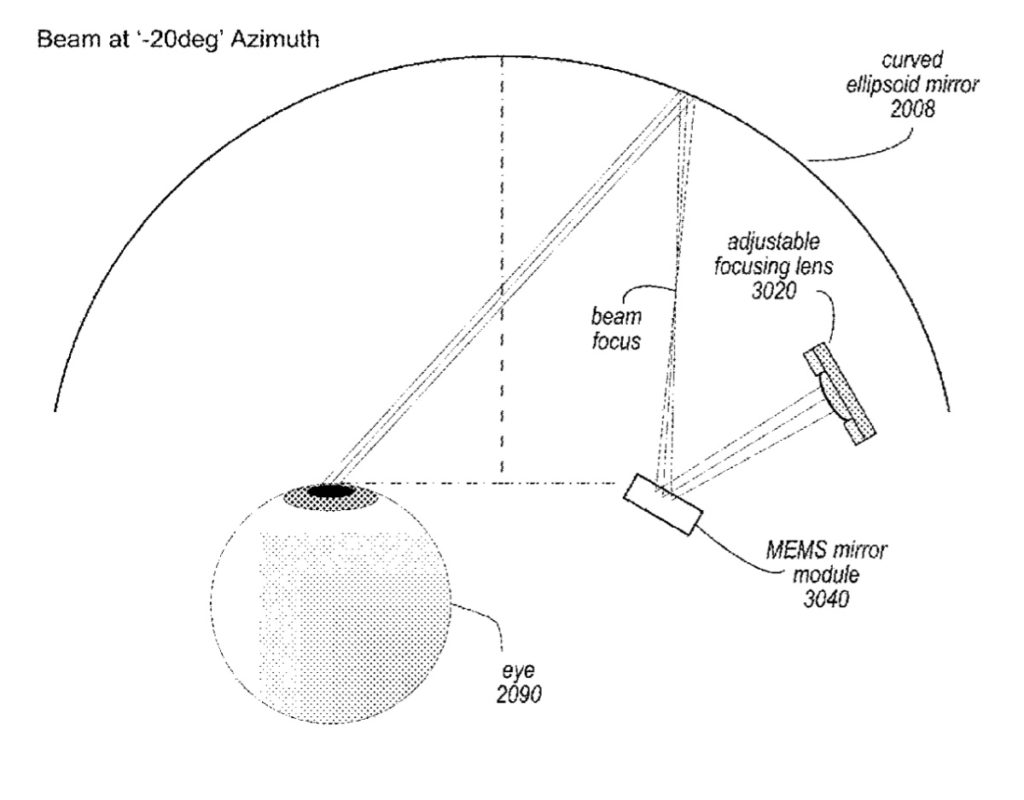The rumored “Apple Glasses” — an augmented reality/virtual reality head-mounted display (HMD) — may project augmented reality (AR) images directly onto a user’s retina. Apple has been granted a patent (number 11.157,072) for “direct retinal projector.”
About the patent
In the patent, Apple notes that virtual reality (VR) allows users to experience and/or interact with an immersive artificial environment, such that the user feels as if they were physically in that environment. For example, virtual reality systems may display stereoscopic scenes to users in order to create an illusion of depth, and a computer may adjust the scene content in real-time to provide the illusion of the user moving within the scene.
When the user views images through a virtual reality system, the user may thus feel as if they are moving within the scenes from a first-person point of view. Similarly, augmented reality (AR) combines computer generated information with real world images to augment, or add content to, a user’s view of the world.
Apple says that, however, conventional virtual reality and augmented reality systems may suffer from accommodation-convergence mismatch problems that cause eyestrain, headaches, and/or nausea. The tech giant adds that accommodation-convergence mismatch arises when a VR or AR system effectively confuses the brain of a user by generating scene content that does not match the depth expected by the brain based on the stereo convergence of the two eyes of the user.
For example, in a stereoscopic system the images displayed to the user may trick the eye(s) into focusing at a far distance while an image is physically being displayed at a closer distance. In other words, the eyes may be attempting to focus on a different image plane or focal depth compared to the focal depth of the projected image, thereby leading to eyestrain and/or increasing mental stress.
Accommodation-convergence mismatch problems are undesirable and may distract users or otherwise detract from their enjoyment and endurance levels (i.e. tolerance) of virtual reality or augmented reality environments. Apple thinks a “direct retina project” may be the answer.
Summary of the patent
Here’s Apple’s abstract of the patent: “A direct retinal projector may include a gaze tracking system that tracks position of a subject’s pupil and automatically adjusts projection of a scanned light field so that the light field enters the pupil. A control loop adjusts a scanning mirror to substantially center an IR beam on a position sensing detector (PSD). In so doing, the scanning mirror is correctly positioned so that the scanned light field from the projector enters the subject’s pupil.
“In addition, a direct retinal projector may include an adjustable focusing element that adjusts focus of a combined light beam generated by a projector as the light beam is scanned to an ellipsoid mirror that reflects the light beam to the subject’s pupil. The focusing of the scanned beam may be adjusted as the beam is scanned across the azimuth angle of the curved ellipsoid mirror.”
About Apple Glasses
When it comes to Apple Glasses, such a device will arrive in 2022 or 2023, depending on which rumor you believe. It will be a head-mounted display. Or may have a design like “normal” glasses. Or it may be eventually be available in both. The Apple Glasses may or may not have to be tethered to an iPhone to work. Other rumors say that Apple Glasses could have a custom-build Apple chip and a dedicated operating system dubbed “rOS” for “reality operating system.”
Article provided with permission from AppleWorld.Today

